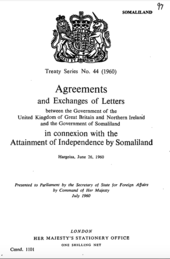State of Somaliland
The arrangement would allow local politicians to gain more political experience in running the protectorate before official independence.
The legislative councils of both territories agreed to this proposal following a joint conference in Mogadishu.
Widespread dissatisfaction spread among the north's population,[14] and British-trained officers attempted a revolt to end the union in December 1961.
[15] During its existence, Somaliland received international recognition from 35 countries,[16] that included China, Egypt, Ethiopia, France, Ghana, Israel, Libya and the Soviet Union.
[5] The constitution established three branches of government following the Westminster system:[25] Muhammad Haji Ibrahim Egal was the first and only holder of the office.
[30][31] However, unlike the former State of Somaliland, it has not gained widespread diplomatic recognition as a country, instead being treated as an autonomous region within Somalia.



